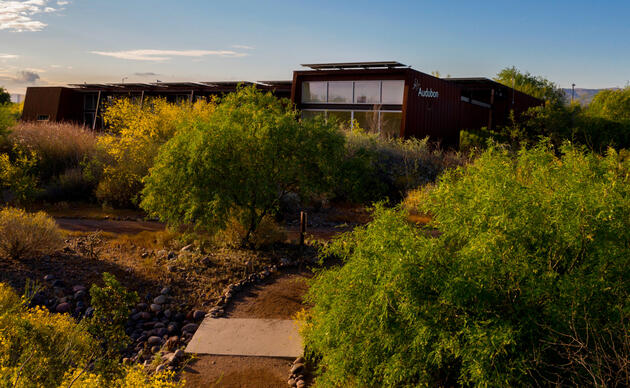The Audubon Southwest Team was busy in 2024 making our facilities look their best, advocating for policies and investments that protect wildlife and natural resources, and ensuring that the renewable energy build out happens in a sustainable way.
Facilities get a Glow Up
At the Nina Mason Pulliam Rio Salado Audubon Center in Phoenix, we installed a new pollinator garden with the help of more than 100 volunteers and generous support from the Society for Ecological Restoration (SER) in collaboration with Microsoft.
The Appleton-Whittell Research Ranch crew made some much-needed upgrades to the historic Swinging H Ranch House, check out the before and after photos in the ranch’s annual report. Staff also provided crucial technical support to Northern Arizona Audubon Society and Desert Rivers Audubon Society, two chapters that are building Motus towers to join the new detection systems monitoring migrating birds in Arizona.
In Santa Fe, New Mexico, the Randall Davey Audubon Center in partnership with Ecoartspace hosted innovative ‘non-art’ installations honoring the history of the site located in the homelands of the Tewa and Apache people. And look for new interpretive signage coming to the Randall Davey Center in 2025.
Land of Enchantment Legacy Funds
The New Mexico Legislature took a major step in securing a sustainable future for the state by fully funding the Land of Enchantment Legacy Fund in the 2024 legislative session. Audubon Southwest staff were instrumental in making this $300 million investment in the fund that will be managed as a trust with annual earnings providing 10’s of millions of dollars for conservation each year. This incredible investment in New Mexico’s resource future will help our lands and wildlife for decades to come.
Bringing Needed Attention to the Lower Colorado River
With ongoing negotiations over rural groundwater management and the future of the Colorado River, Audubon Southwest continues to be a leading voice for improving Arizona’s water security and protecting groundwater resources in the state.
During our 8th annual Western Rivers Day at the Arizona Legislature, Sonoran Audubon Society, Maricopa Audubon Society, Desert Rivers Audubon Society, and Yuma Audubon Society chapters joined us to rally supporters to advocate on behalf of our policy priorities.
We created an award-winning StoryMap that allows users to explore the different habitats along the Lower Colorado River.
We also received a prestigious federal grant to plan and develop habitat improvement projects along the Lower Gila River west of Phoenix in partnership with the Lower Gila River Collaborative.
Water Deliveries Continued and Funded through 2033
In New Mexico, we are ensuring the Rio Grande remains a verdant ribbon of life, through continued advocacy as well as on-the-ground action that includes leasing water to release into the Middle Rio Grande to bolster environmental flows that are threatened by over-allocation and crumbling infrastructure. Again in 2024, Audubon Southwest partnered with the Middle Rio Grande Conservancy District to deliver more than 6,000-acre feet of water to the drying Rio Grande while also conducting vegetation treatments to improve critical habitat for a variety of species. We also entered into an agreement with Meta who will continue to fund additional water leasing through the year 2030.
We also continue to advocate in Santa Fe for policies and investments that secure our water future statewide, including providing leadership to the Rio Grande Basin Study, rallying our chapters to give input on regional water planning efforts, and advocate for investments in water management at the upcoming legislative session.
Finding solutions for wildlife and renewable energy challenges
Following the publication of Audubon’s Birds and Transmission Report and our support for the Sunzia renewable energy project, Audubon Southwest is leading the way among environmental non-governmental organizations in the region as we work to build out a renewable energy program that works at multiple scales to influence permitting processes, siting decisions and mitigation plans to achieve the best outcomes for birds and people. Recently, we released a set of Conservation Priorities for Renewable Energy and Transmission that we developed with partners to inform siting decisions in Arizona and are currently working on a similar document for New Mexico. Despite a narrative that sometimes pits renewable energy and wildlife conservation interests against one another, it is not only possible but imperative to solve these two issues in tandem at the policy and the project level.
To learn more about this and all of our work at Audubon Southwest, read our Impact Report.
And of course, none of this is possible without your generous support, so please consider a donation to the National Audubon Society as 2024 draws to a close.
Happy Holidays.



